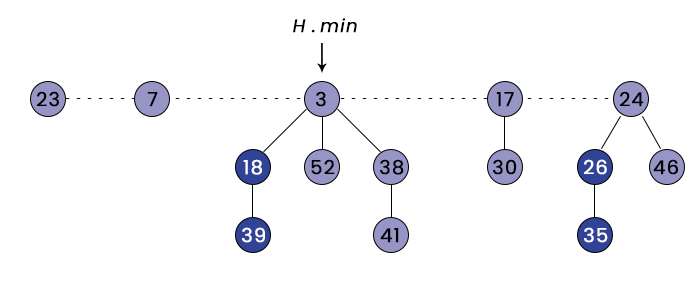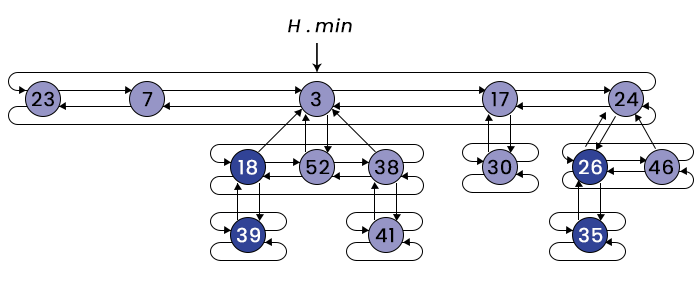Fibonacci HeapIn this article, we will learn about the Fibonacci heap, its properties, advantages and, later on, its implementation: Before discussing the Fibonacci heap, let us first take a quick overview of ideas used in building a Fibonacci heap: What are heaps in data structure? Heaps are the abstract data type which is used to show the relationship between parents and children: Heap is categorized into Min-Heap and Max-Heap:
What is a circular doubly-linked list in data structure? A doubly-linked list is the advanced version of the singly-linked list. Each node in a double-linked list contains two pointers left and right pointers. The left-pointer points to its left node, and the right-pointer points to the right node. The right pointer of the last node points to the first node, and the left pointer of the first node points to the last node. The figure shows how a circular doubly-linked list is observed: Let us now discuss the Fibonacci heap: Define Fibonacci Heap: Fibonacci Heap - A Fibonacci heap is defined as the collection of rooted-tree in which all the trees must hold the property of Min-heap. That is, for all the nodes, the key value of the parent node should be greater than the key value of the parent node: The given figure is an example of the Fibonacci tree: 
The above Fibonacci Heap consists of five rooted min-heap-ordered trees with 14 nodes. The min-heap-ordered tree means the tree which holds the property of a min-heap. The dashed line shows the root list. The minimum node in the Fibonacci heap is the node containing the key = 3 pointed by the pointer FH-min. Here, 18, 39, 26, and 35 are marked nodes, meaning they have lost one child. The potential of the Fibonacci series = No. of rooted tree + Twice the number of marked nodes = 5 + 2 * 4 = 13. Let us now observe the above example with the complete representation of the Fibonacci Heap: 
In the above figure, we can observe that each node contains four pointers, the parent points to the parent (Upward), the child points to the child (downward), and the left and right pointers for the siblings (sideways). Properties of Fibonacci Heap:
The time complexities of different operations performed on a Fibonacci heap are listed below in the table:
1. Creating a Fibonacci Heap: In an empty Fibonacci Heap (FH) The number of rooted trees, t(FH) = zero, The minimum node, FH -> min = NIL, Number of nodes, FH -> n = 0, Number of marked nodes, FH -> m = 0, and The potential of the empty Fibonacci heap ?(FH) = 0. It is created by the MAKE-FIB-HEAP, which allocates and returns the Fibonacci heap object, FH in amortized cost O(1) equal to its actual cost: 
Insertion of a node: The below pseudo code of INSERT-FIB-HEAP inserts a node x in the Fibonacci heap, FH. Assume that the node x has already been allocated and x -> key is already filled: Line-wise explanation of the INSERT_FIB_HEAP (FH, X) pseudo-code:
2. Union of two Fibonacci Heap: The below pseudo-code simply concatenates the root lists of two Fibonacci heaps, FH1 and FH2 and destroys both of them during the process, determines the min node and returns the new Fibonacci heap, FH. Line-wise explanation of UNION-FIB-HEAP (FH1, FH2) pseudo-code:
3. Extracting the Minimum Node: The extraction of minimum Node is one of the most complicated operations performed on the Fibonacci Heap. It is also where the delayed work of consolidating trees in the root list finally occurs. The below pseudo-code extracts the minimum node of the Fibonacci tree. For ease of use, the code assumes that when a node is removed from a linked list, pointers in the list are updated but not pointers in the extracted node. Additionally, it invokes the auxiliary procedure CONSOLIDATE, which we'll see in a moment. Line-wise explanation of EXTRACT-MIN-FIB-HEAP (FH) pseudo-code:
Line-wise explanation of the CONSOLIDATE (FH) pseudo-code: 2544 1. In line 1, it creates a new array of size D (FH -> N) 2. In lines 2 and 3, it fills NIL at all indexes of A. 3. - In lines 4 to 15, it executes the same process for all the nodes present in the root list. It selects each node 'W' from the root list and stores it in 'X'. Then, it stores the degree of X in d and runs a while loop if, at index d, it is not NIL. But initially, all the values are NIL, so, it won't execute, and in line 14, it stores 'X' at index d. Now, the idea of while is to check whether there is any node present in the root list of the same degree as of 'X'. In the second iteration of the for-loop, it selects another node from the root list and stores it in X and its degree in d. The while condition becomes true if there is a node in the root list of the same degree as of 'X'. Suppose the condition of the while-loop is true. Now, it stores the node of the same degree as of 'X' in Y and checks which has the larger key. If Y has a key larger than the key of X., it swaps both of them and calls LINK-FIB-HEAP (FH, Y, X) to delete the Y from the root list after making it a child of X, and it also increases the degree of X by one after that. In line 12, it removes the element stored at index d in the array and increases the value of d by 1. The whole idea of the code is to have exactly one node of each degree in the root list and make other nodes a child of them without violating the condition of the Fibonacci heap. 4. In lines 16 to 24, It runs a for loop for all the nodes stored in the array. Firstly, it checks whether there is an element present in the array at index I or not. If yes, then it executes the other peace of codes. Now, it checks whether the min of FH is NIL or not. If yes, then it creates a root list and stores the A[I] into it and makes the FH -> min points to it. If not, then it inserts the A[I] into the root list and compares its key value with the min -> key. Whosoever has the smallest key, FH -> min will point to the smallest of them. Line-wise explanation of the LINK-FIB-HEAP (FH, Y, X) pseudo-code: 1. It removes the Y from the root list 2. Makes the Y nodes a child of X and increases the degree of X by 1 3. Marks FALSE in the Y -> mark. 4. Decreasing a Key Decreasing a key is performed on the Fibonacci heap to decrease the key of any node and can be performed in the O(1) amortized time. In the below pseudo code, we have assumed that removing a from the linked list does not change any of the structural attributes in the removed node. 
Line-wise explanation of DECREASE-Key-FIB-HEAP (FH, X, K) pseudo-code: 1. In lines 1 to 2, it checks whether the key entered is greater than the existing key or not. If yes, the program terminates and will not change anything in the Fibonacci heap. 2. In line 3, Updates the key of X; now, X -> Key is equal to the k 3. In line 4, It stores the parent of X in Y 4. In line 5, The if condition will become true only if the node X does not belong to the root list, i.e., there exists a parent of it, and the key of X must be smaller than the key of Y. 5. In line 6, it calls CUT (FH, X, Y) to remove X from the F and add it to the root list 6. In line 7, It calls CASCADING-CUT (FH, Y) to mark True in Y or to remove it from the linked list and add it to the root list. 7. In line 8, It checks whether the X has the key smaller than the FIB -> min -> Key or not 8. In line 9, if the condition is satisfied then it makes X the min of the Fibonacci heap. Explanation of CUT (FH, X, Y) Pseudo-code: In the above pseudo-code, it first finds the parent of Y and stores it in Z. Then, it checks whether the Y is in the root list or not. If not means Z is not equal to NIL, Again, it checks whether it is marked or not, If it is marked FALSE then it changes it to TRUE and the control returns to the FIB-DECREASE-KEY. If it is marked TRUE, then it removes Y from Z and places Y in the root list and repeats the same process and stops when one of the parent nodes is found unmarked. 5. Deleting a Node: The deleting a node from an n-node Fibonacci heap can be performed in O(D(n)) amortized cost time. In the below pseudo-code, we have assumed that as of now there is no key value of -infinity in the heap. The DECREASE-KEY-FIB-HEAP (FH, X, -∞) decreases the key of X and makes it the smallest possible value i.e., -infinity. The EXTRACT-MIN-HEAP function removes X from the Fibonacci heap. It can be concluded that the amortized cost of the DELETE-FIB-HEAP is the sum of the amortized cost of DECREASE-KEY-FIB-HEAP (O(1)) and the amortized cost of the EXTRACT-MIN-HEAP (O(D(n)). |
 For Videos Join Our Youtube Channel: Join Now
For Videos Join Our Youtube Channel: Join Now
Feedback
- Send your Feedback to [email protected]
Help Others, Please Share









